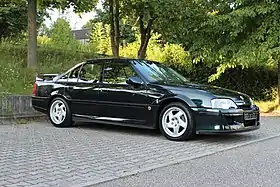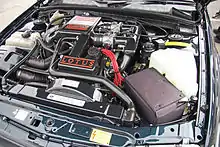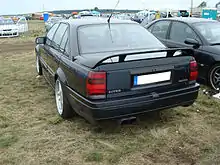Lotus Carlton
The Lotus Carlton (also called Vauxhall Lotus Carlton, Lotus Omega and Opel Lotus Omega) is a Vauxhall Carlton/Opel Omega A saloon upgraded by Lotus in order to be able to reach speeds up to 285 km/h (177 mph) with acceleration to equal contemporary sports cars. Like all Lotus vehicles, it was given a type designation—Type 104 in this case. The exterior changes were minimal with the addition of a rear spoiler, cooling vents on the bonnet, Lotus badges on the front wings and bootlid, a bodykit and considerably wider wheel arches distinguishing it from a standard Carlton/Omega.[2] The car was only sold in one colour, a shade of green called Imperial Green (similar to British Racing Green).
| Lotus Carlton | |
|---|---|
 | |
| Overview | |
| Manufacturer | Lotus (General Motors) Opel/Vauxhall (General Motors) |
| Also called | Opel Lotus Omega Vauxhall Lotus Carlton |
| Production | 1990–1992 |
| Assembly | United Kingdom: Hethel, Norfolk |
| Body and chassis | |
| Class | Sports saloon |
| Body style | 4-door saloon |
| Layout | Front-engine, rear-wheel-drive |
| Platform | GM V-body |
| Related |
|
| Powertrain | |
| Engine | 3.6 L Opel C36GET twin-turbocharged I6 |
| Power output | 382 PS (281 kW; 377 hp) |
| Transmission | 6-speed ZF S6-40 manual |
| Dimensions | |
| Wheelbase | 2,730 mm (107.5 in) |
| Curb weight | 1,655 kg (3,649 lb)[1] |
| Chronology | |
| Predecessor | Lotus Cortina |
Engine and drivetrain


Performance modifications started with an upgraded engine, which was enhanced by Lotus from the standard Opel 3.0 L (2,969 cc) 24v straight six unit (used in the GSi). The engine was enlarged to a capacity of 3,615 cc (3.6 L).[3] Lotus then added two Garrett T25 turbochargers, which provide up to 0.7 bar (10 psi) of boost from about 1,500 rpm. The original distributor ignition system of the engine was replaced with a three-coil wasted spark system. The distributor drive was re-purposed as a water pump drive for the water-air intercooler circuit. The intercooler itself is manufactured by Behr and is capable of reducing the temperature of the compressed charge from 120 °C (248 °F) to 60 °C (140 °F).[4][5]
In addition to the aforementioned engine modifications, Lotus directed a number of engineering changes to the engine so that it would perform reliably with the higher power output. To cope with the higher cylinder pressures (about 95 bar (9,500 kPa)), the external webbing on the engine block was reinforced. The crankshaft was replaced as well; early development crankshafts were machined from billet steel in Italy, but the production units were forged by Opel and sent to Maschinenfabrik Alfing Kessler for machining. The cylinder head was left mostly the same as the 4 valves per cylinder from the donor car, although the combustion chamber was milled to reduce the static compression ratio to 8.2:1 (from 10.0:1). The engine was fitted with forged slipper pistons produced by Mahle. Piston connecting rods were replaced with new units made to an original Lotus design.[4]
The same ZF 6-speed manual transmission as fitted to a contemporary Chevrolet Corvette ZR-1 was used to transfer power output to the rear wheels via a rear limited-slip differential shared with the V8 Holden Commodore.
Chassis, brakes, and steering
The multi-link suspension of the Omega, already praised by the automotive press, was modified by Lotus for better high-speed stability and improved handling dynamics. To combat the problem of significant camber change (seen with the car at high speed and when fully laden), the self-leveling suspension from the Opel Senator was fitted. Also borrowed from the Senator was the Servotronic power steering system, which provides full power assist at parking speeds, and reduces the power assist as the road speed increases. The Lotus engineers would have preferred using a rack and pinion steering arrangement, but cost and space constraints limited them to the worm-and-roller arrangement.[4]
Initial sketches for the wheels showed a split-rim composite design, but this was ultimately abandoned in favor of a monoblock wheel design, with cited concerns over the durability of the wheels in poor road conditions. The final design for the 17-inch wheels was manufactured by Ronal, along with wider tyres than those used on the Omega.[3] The Omega is fitted with Goodyear Eagle tyres. The tyre compound used is the same as that on the Esprit Turbo SE, with a combination of oils and low hysteresis. This allows for improved high-speed stability and better performance in wet conditions.[4]
The car is fitted with 12.9 in (328 mm) brake discs with four-piston AP calipers at the front and 11.8 in (300 mm) discs with two-piston calipers at the rear.[4]
Performance
The twin-turbocharged inline-6 engine in the Carlton (code-named C36GET) has a power output of 382 PS (281 kW; 377 hp) at 5,200 rpm and 568 N⋅m (419 lb⋅ft) of torque at 4,200 rpm, of which 470 N⋅m (350 lb⋅ft) was available from 2,000 rpm.[6] The car was capable of accelerating from 0–97 km/h (60 mph) in 5.2 seconds, and going from 0–124–0 km'h in less than 17 seconds. Tall gearing allows it to achieve approximately 89 km/h (55 mph) in first gear. The Lotus Carlton/Omega held the title of the second fastest four-door saloon for some years, after the Alpina B10 Bi-Turbo.
Reception
Because the Carlton/Omega could equal or exceed the performance of many contemporary sports cars from the likes of Ferrari and Porsche, while also comfortably carrying four passengers, it generated some controversy among the automotive and general press. Bob Murray, then editor of Autocar magazine, wrote: "Nobody buying this car could possibly argue he either needs or will be able to use a top whack which is claimed to be around 180 mph", and suggested that Vauxhall should follow the example set by German automakers (who had begun electronically limiting the top speed of their high-performance cars to 155 mph). Ultimately, Opel did not restrict the car's top speed.[4]
On 26 November 1993 a Lotus Carlton was reported stolen from a home in the West Midlands with the plates "40RA". In the following months, a gang of thieves used the car to conduct ram raids between 12 a.m. and 5 a.m. stealing around 20,000 GBP worth of liquor and cigarettes. A local police officer, David Oliver said, "We simply haven't been able to get near the thing and it looks unlikely that we ever will". This is because the local police cars - mostly Austin Metros - could only barely hit 90mph while the Lotus Carlton almost doubled it. The ram raiders also hid their stolen Lotus Carlton during the day and no one could ever find it. The car was never recovered and its current whereabouts is unknown. Because of these ram raids involving the Lotus Carlton, the U.K. government deemed the car "unsafe" and "unreasonable" for anyone to need to own a saloon that could go 177mph. Despite gaining traction, the campaign to ban the Lotus Carlton ultimately failed.
Production
Production of the Lotus Carlton/Omega began in 1990, four years after the original Omega went on sale. Opel had hoped to build 1,100 cars in total, but owing to the recession of the early 1990s, the Carlton/Omega priced at £48,000 was not selling as well as anticipated and production at Lotus was halted in December 1992. Only 950 cars were completed: 320 Carltons and 630 Omegas, 150 short of the original target. The cars are now starting to become modern classics as low-mileage, well-looked-after examples become rare.[7]
In 1991, the Italian design house Pininfarina produced a styling concept named the "Chronos" that was designed to accept the drivetrain from the Lotus Omega. The single example of the Chronos (sans engine) was displayed at the 1991 Detroit Auto Show.[4]
Other markets
While the base Omega A and the Lotus Omega were never federalized for sale in the US, the Omega was cleared for grey import under the DOT's "Show or Display" exemption in 2011.[8] By the end of 2017, all model years of the Carlton were past the 25-year mark, making them exempt from NHTSA import restrictions.
Specifications
| Top speed | +283 km/h (176 mph) |
|---|---|
| Acceleration | 0-97 km/h (60 mph): 5.1 seconds 0-160 km/h (100 mph) : 11.1 sec.[9] |
| Peak power output | 382 PS (281 kW; 377 hp) at 5,200 rpm |
| Peak torque | 568 N⋅m (419 lb⋅ft) at 4,200 rpm |
| Displacement | 3,615 cc (3.6 L) |
| Engine type | Twin-turbocharged Straight-6 |
| Layout | Longitudinal, Front-engine, rear-wheel drive |
| Transmission | Six-speed ZF S6-40 manual |
| Weight | 1,655 kg (3,649 lb) |
| Production | 950 units |
| Price | £48,000 |
References
- Meaden, Richard (19 February 2013). "BMW M5 vs Lotus Carlton". EVO magazine. Retrieved 18 December 2018.
- "Lotus Carlton voted favourite Vauxhall of all time". The Daily Telegraph. 2 December 2008.
- "Vauxhall Carlton Lotus 4dr review - design", Autocar, 28 November 1990
- Adcock, Ian (1991). Lotus Carlton. Osprey Publishing. ISBN 1-85532-185-8.
- "Driven: Lotus Carlton". PistonHeads.
- Craig Cheetham. Supercars. Motorbooks. pp. 118–119. ISBN 0-7603-2565-0.
- "Sub-£10k super-saloons". PistonHeads. 18 January 2007.
- http://www.nhtsa.gov/cars/rules/import/sdlist040109.pdf
- "Vauxhall Carlton Lotus 4dr review - data", Autocar, 28 November 1990
External links
| Wikimedia Commons has media related to Opel Omega Lotus. |
- Photo
- Audi RS6 v Jaguar S-Type R v BMW M5 (v Carlton) - evo magazine